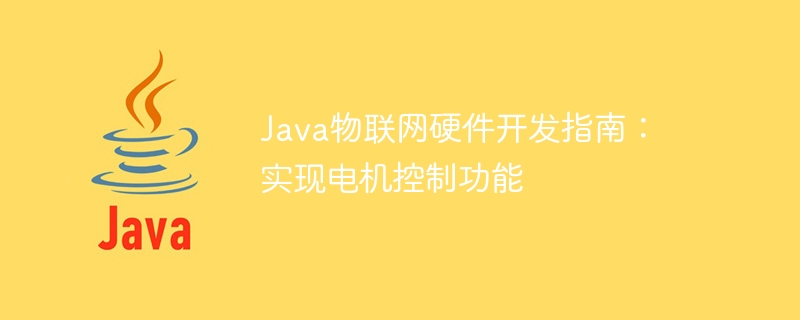Home >Java >javaTutorial >Java IoT Hardware Development Guide: Implementing Motor Control Functions
Java IoT Hardware Development Guide: Implementing Motor Control Functions
- 王林Original
- 2023-09-21 15:45:41944browse

Java Internet of Things Hardware Development Guide: To implement motor control functions, specific code examples are required
Introduction:
With the rapid development of Internet of Things technology, people’s daily More and more devices and items in life are connected to the Internet. As a widely used programming language, Java is widely used in IoT hardware development. This article will introduce in detail how to use Java to implement motor control functions and provide code examples.
- Understand the basics required for IoT hardware development
Before you begin, some basic knowledge is necessary. First, we need to understand the circuit principles and motor control knowledge required for IoT hardware development. Secondly, we need to be familiar with the Java programming language and understand its basic syntax and object-oriented concepts. - Preparing the development environment
Before developing the IoT hardware, we need to prepare the development environment. First, you need to install the Java Development Kit (JDK). Secondly, we need to choose a suitable integrated development environment (IDE), such as Eclipse or IntelliJ IDEA. - Connecting Hardware Devices
Before performing motor control, we need to connect the hardware devices to the computer. This may require some hardware devices such as an Arduino or Raspberry Pi, as well as some sensors and peripherals. Make sure the hardware device is connected correctly and that the computer recognizes the device. - Writing code
Next, we will write Java code to implement the motor control function. The following code example assumes we are using an Arduino as the hardware device and connecting a DC motor.
import com.fazecast.jSerialComm.SerialPort;
public class MotorControl {
public static void main(String[] args) {
// 选择串口
SerialPort[] serialPorts = SerialPort.getCommPorts();
SerialPort arduinoPort = serialPorts[0];
// 打开串口
if (arduinoPort.openPort()) {
System.out.println("串口已打开");
} else {
System.out.println("无法打开串口");
return;
}
// 设置串口参数
arduinoPort.setComPortTimeouts(SerialPort.TIMEOUT_SCANNER, 0, 0);
arduinoPort.setBaudRate(9600);
// 控制电机旋转
byte[] buffer = new byte[1];
buffer[0] = 1; // 假设1表示电机正转,0表示停止
arduinoPort.writeBytes(buffer, 1);
}
}- Test Motor Control
After writing the code, we can test the motor control functionality. Make sure the hardware device is connected correctly and upload the code to the hardware device. Then, we can observe the operation of the motor to see whether the corresponding control function is implemented.
Conclusion:
This article introduces how to use Java to implement motor control functions in IoT hardware development and provides corresponding code examples. Through learning and practice, we can better understand the basic knowledge and technology of IoT hardware development and lay a solid foundation for realizing more functions and innovations. I hope this article can be helpful to readers in their learning and practice in IoT hardware development.
The above is the detailed content of Java IoT Hardware Development Guide: Implementing Motor Control Functions. For more information, please follow other related articles on the PHP Chinese website!
Related articles
See more- PHP IoT Hardware Development Example: Learn Device Control with Sample Code
- Java IoT Hardware Development Guide: Implementing Smart Curtain Control Function
- Java IoT Hardware Development Guide: Implementing Intelligent Flood Alarm Function
- Java IoT Hardware Development Guide: Implementing Smart Water Meter Functions
- Java Internet of Things Hardware Development Tutorial: Implementing Intelligent Lighting Control Functions

